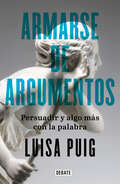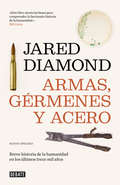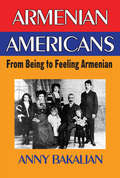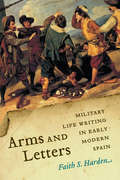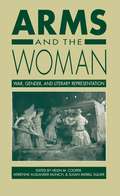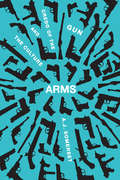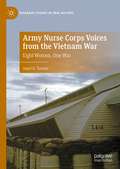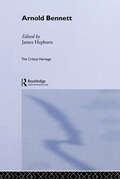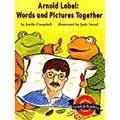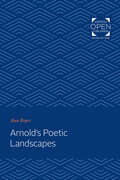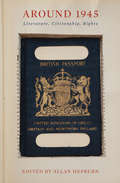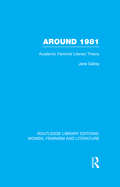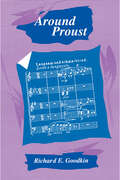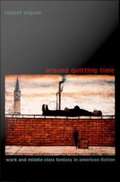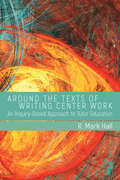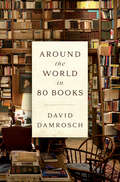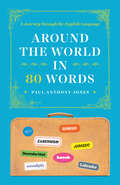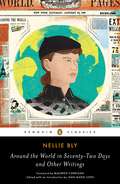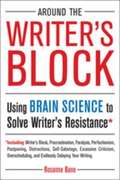- Table View
- List View
Armarse de argumentos
by PUIG LLANO LUISA ANGELICAUn primer acercamiento lo suficientemente amplio y profundo, para dotar a los interesados en la argumentación con herramientas que les permitan acceder a este campo de estudio y a la práctica que se deriva de su conocimiento. Ningún sujeto hablante, ningún ser humano, escapa a la necesidad de recurrir a la argumentación. Ya sea para resolver algún problema relacionado con el ámbito del trabajo, el comercio, la justicia, la política, la cultura o las relaciones personales. Tampoco somos ajenos a la influencia cotidiana de los medios donde se discuten, critican y dirimen toda clase de asuntos, ni mucho menos al acoso de la publicidad, que nos persigue alardeando las supuestas virtudes de los productos que busca vender. Para Aristóteles, la argumentación es algo que se enseña y se aprende. Armarse de argumentos tiene como objeto satisfacer precisamente ese interés e imperiosa necesidad. En él se aborda el origen de esta disciplina, centrando la atención en su primer gran texto fundador, la Retórica del gran filósofo estagirita. Son de particular interés los desarrollos teóricos modernos en esta materia, así como el estudio de aquellos aspectos de la lengua que inciden de manera directa o indirecta en la argumentación. Esta obra aborda, igualmente, las problemáticas acerca del cómo se argumenta, mediante el análisis de diversas modalidades de textos, así como la manera de llevar a cabo esta práctica interactiva tan propia de los seres humanos.
Armas, gérmenes y acero: Breve historia de la humanidad en los últimos trece mil años
by Jared DiamondArmas, gérmenes y acero, Premio Pulitzer 1997, cuestiona la prepotente visión occidental del progreso humano y nos ayuda a comprender cómo el mundo moderno y sus desigualdades han llegado a ser como son. Hace 13.000 años la evolución de las distintas sociedades humanas comenzó a tomar rumbos diferentes. La temprana domesticación de animales y el cultivo de plantas silvestres en el Creciente Fértil, China, Mesoamérica y otras zonas geográficas otorgó una ventaja inicial a sus habitantes. Sin embargo, los orígenes localizados de la agricultura y la ganadería son solo una parte de la explicación de los diferentes destinos de los pueblos. Las sociedades que superaron esta fase de cazadores-recolectores se encontraron con más probabilidades de desarrollo, supervivencia y poder bélico. Reseña:«Uno de los estudios históricos más originales y sugerentes de los últimos años.»Juan Avilés, El Mundo
Armchair Archaeology
by Becky ChestonThe final installment of the Reading Street curriculum series, Reading Street: Grade 6, comes complete with everything you'll need to create English and Language Arts lessons for your child. This system includes reading selections designed to help your child hone his or her skills, a Teacher Resource DVD to make your task of developing lessons easier, and a packet of curriculum materials. Reading Street: Grade 6 is a comprehensive system designed to enhance your child's skills in reading, writing and language. Each assignment in Reading Street helps your child progress toward that goal. While such a dynamic curriculum might sound challenging for you as a parent and educator to use, you can rest assured that the materials will guide you through 12 weeks of English and Language Arts lesson planning with ease. If you prefer a structured homeschooling program format, Reading Street (in all of its Grade level structures) is the right fit for you and your child. Grade 6 comes with two volumes of six units. By the time you complete Grade 6, your child will be able to: Read through a variety of complex literature, including biographies and fictional stories. Discover additional reading material based on personal taste. Relate individual chapters or concepts to the book as a whole. Write complete stories using proper grammar, punctuation and word choice. Compose a written argument using appropriate sources. Examine and edit his or her own writing, as well as the writing of others. Present an oral presentation based on the lessons. Unlike other curricula, Reading Street imparts a love of reading upon your child. From Grade 1 through Grade 6, your child will learn not only the skills he or she needs to advance his or her education, but become a lifelong student and reader. For more information about the specific materials included in the Reading Street: Grade 6 curriculum for homeschooling, visit the Features and Benefits page.
Armenian-Americans: From Being to Feeling American
by Anny BakalianAssimilation has been a contentious issues for most immigrant groups in the United States. The host society is assumed to lire immigrants and their descendants away from their ancestral heritage. Yet, in their quest for a "better" life, few immigrants intentionally forsake heir ethnic identity; most try to hold onto their culture by transplanting their traditional institutions and recreating new communities in America. Armenian-Americans are no exception. Armenian-Americans have been generally overlooked by census enumerators, survey analysts, and social scientists because of their small numbers and relative dispersion throughout the United States. They remain a little-studied group that has been called a "hidden minority." Armenian Americans fills this significant gap. Based on the results of an extensive mail questionnaire survey, in-depth interviews, and participant observation of communal gatherings, this book analyzed the individual and collective struggles of Armenian-Americans to perpetuate their Armenian legacy while actively seeking new pathways to the American Dream. This volume shows how men and women of Armenian descent become distanced from their ethnic origins with the passing of generations. Yet assimilation and maintenance of ethnic identity go hand-in-hand. The ascribed, unconscious, compulsive Armenianness of the immigrant generation is transformed into a voluntary, rational, situational Armenianness. The generational change is from being Armenian to feeling Armenian. The Armenian-American community has grown and prospered in this century. Greater tolerance of ethnic differences in the host society, the remarkable social mobility of many Armenian-Americans and the influx of large numbers of new immigrants from the Middle East and Soviet bloc in recent decades have contributed to this development. The future of this community, however, remains precarious as it strives to adjust to the ever changing social, economic, and political conditions affec
Armer Heinrich, reicher Heinrich - Deutscher Heinrich: Die literarische Karriere eines Namens im neunzehnten Jahrhundert
by Rebecca RichterDer Eigenname ist als sprachliches Phänomen Gegenstand vielfältiger wissenschaftlicher Betrachtung. In der Literatur erfüllt er seine Funktion unter anderem durch sein assoziatives Potenzial, das im Einzelwerk herauszuarbeiten eine literaturwissenschaftliche Grunddisziplin darstellt. Nun wird die deutsche Literatur des neunzehnten Jahrhunderts von einem einzelnen Namen in auffälliger Weise dominiert, nicht nur ob seiner Häufigkeit, sondern vor allem durch die prominente Platzierung in den großen und größten Werken dieser Zeit. Heinrich von Ofterdingen steht neben Heinrich Faust, der grüne Heinrich neben der Königlichen Hoheit Klaus Heinrich. Dabei ist der Eigenname per definitionem zu keiner Zeit ein unbeschriebenes Blatt. Rebecca Richter zeigt, dass der deutsche Herrschername schlechthin durch das neunzehnte Jahrhundert zum deutschen Dichtermythos erweitert wird, dem Künstler-Ich, das in einer sich modernisierenden und ökonomisierenden Welt entweder flüssig wird, oder sich verflüchtigt: Die Anlage zu beidem bringt Heinrich bereits im Namen mit.
Arms and Letters: Military Life Writing in Early Modern Spain (Toronto Iberic)
by Faith S. HardenArms and Letters analyses the unprecedented number of autobiographical accounts written by Spanish soldiers during the sixteenth and seventeenth centuries. These first-person retrospective works recount a range of experiences throughout the sprawling domain of the Hispanic monarchy. Reading a selection of autobiographies in contemporary historical context – including the coalescing of the first modern armies, which were partially populated by forced recruits and the urban poor – Faith S. Harden explains how soldiers adapted the concept of honour and contributed to the burgeoning autobiographical form. Harden argues that Spanish military life writing took two broad forms: the first as a petition, wherein the soldier’s service was presented as a debt of honour, and second, as a series of misadventures, staging honour as a spectacle that captivated an audience. Honour was inevitably gendered and performative, and as such, it functioned as one of the overarching metrics of value that early modern men and women applied to themselves and others. In charting how non-elite subjects rendered their lives legitimate through autobiography, Arms and Letters contributes both to a critical genealogy of honour and to the history of life writing.
Arms and the Woman
by Susan Merrill Squier Adrienne Auslander Munich Helen M. CooperAlthough the themes of women's complicity in and resistance to war have been part of literature from early times, they have not been fully integrated into conventional conceptions of the war narrative. Combining feminist literary criticism with the emerging field of feminist war theory, this collection explores the role of gender as an organizing principle in the war system and reveals how literature perpetuates the ancient myth of "arms and the man."The volume shows how the gendered conception of war has both shaped literary texts and formed the literary canon. It identifies and interrogates the conventional war text, with its culturally determined split between warlike men and peaceful women, and it confirms that women's role in relation to war is much more complex and complicitous than such essentializing suggests. The contributors examine a wide range of familiar texts from fresh perspectives and bring new texts to light. Collectively, these essays range in time from the Trojan War to the nuclear age. The contributors are June Jordan, Lorraine Helms, Patricia Francis Cholakian, Jane E. Schultz, Margaret R. Higonnet, James Longenbach, Laura Stempel Mumford, Sharon O'Brien, Jane Marcus, Sara Friedrichsmeyer, Susan Schweik, Carol J. Adams, Esther Fuchs, Barbara Freeman, Gillian Brown, Helen M. Cooper, Adrienne Auslander Munich, and Susan Merrill Squier.
Arms: The Culture and Credo of the Gun
by Andrew SomersetIn Arms: the Culture and Credo of the Gun, novelist, journalist, sports shooter, and former army reservist A.J. Somerset offers up one of the first looks at the gun as our pre-eminent cultural symbol of power and asks how it got that way. <P><P>Pouring through the various cultural battlefields of 19th- and 20th-century North America, including film, literature, music, videos games, and history, Somerset charts how the gun went from a tool in the hands of the earliest pioneers, used to defend the homestead and put food on the table, to a kind of totem, instantly capable of dividing communities. Sharp-eyed and acerbic, sure-handed and sportive, Arms presents an intellectual and cultural history that is certain to enrage, entertain, and provoke debate, while showing that the gun cultures of Canada and the United States may not be so different after all. If guns, as the NRA often exclaims, do not kill people, Somerset shows how the idea of the gun has become something many believe worth dying for.
Army Nurse Corps Voices from the Vietnam War: Eight Women, One War (Palgrave Studies in Oral History)
by Janet D. TannerThis book provides an oral history of women who served in the U.S. Army Nurse Corps during the Vietnam War. It follows the trajectory of eight women’s lives from their decision to become nurses, to surgical and evacuation hospitals in Vietnam, and then home to face the consequences of war on their personal and professional lives. It documents their lived experience in Vietnam and explores the memories and personal stories of nurses who treated injured American soldiers, Vietnamese civilians, and the enemy. Their voices reveal the physical and emotional challenges, trauma, contradictions, and lingering effects of war on their lives. Women in the U.S. Army in Vietnam feared the enemy but also sexual violence and harassment: the experiences this book documents also shed light on the extent of historical sexual abuse in the military.
Arnold Bennett
by James HepburnThis set comprises fory volumes covering nineteenth and twentieth century European and American authors. These volumes will be available as a complete set, mini boxed sets (by theme) or as individual volumes. This second set compliments the first sixty-eight volume set of Critical Heritage published by Routledge in October 1995.
Arnold Lobel: Words and Pictures Together [Grade 2]
by Joelle Campbell Judy SteadNIMAC-sourced textbook
Arnold's Poetic Landscapes
by Alan RoperOriginally published in 1969. Alan Roper studies the degree to which Arnold achieved a unity of human significance and literal landscape. If landscape poetry is to rise above the level of what Roper calls "country contentments in verse," the poet cannot think and describe alternately; his thinking and describing must be a part of one another. That Matthew Arnold was aware of the difficulty in achieving the necessary unity becomes clear in his own criticism, which Roper examines along with a large and representative number of Arnold's poems. Considering the latter roughly in the order they were published—except for a fuller analysis of Empedocles on Etna, "The Scholar-Gipsy," and "Thyrsis"—Roper follows important changes in Arnold's view of the function and nature of poetry as it emerged in the poems themselves. Basic to the author's critical method is a distinction between geographical sites and poetic landscapes. Focusing on the ways that Arnold and, to a lesser extent, the Augustan and Romantic poets before him untied thought and description, Roper adds a critical dimension to Arnold scholarship. Concerned not with the development of Arnold's ideas nor with their sources in classical antiquity and the Romantic period, he considers Arnold a self-conscious poet who, though sometimes successful, became increasingly unsuccessful in his efforts to imbue a landscape with meaning for individual or social man.
Around 1945: Literature, Citizenship, Rights
by Allan HepburnNear the end of the Second World War, new ideas about citizenship, national identity, belonging, and rights emerged as the atrocities of the war – coupled with the dropping of atomic bombs on Hiroshima and Nagasaki – spurred writers and citizens around the world to think about their responsibilities to their fellow man. Covering British authors and contemporary fiction by migrant writers publishing at mid-century, as well as some photography from the era, Around 1945 is a collection of essays that reveals how literary texts and cultural events modeled human rights issues such as dignity, freedom, sovereignty, and responsibility. Unified by an investigation of the human and cultural aspects of universal rights, these essays show that British writers tested the parameters of citizenship and rights in novelistic form. By imagining duties and rights of citizens in hypothetical contexts, these novels expanded on the legislated entitlements and obligations that make up civic and human identity. To this day the repercussions of 1945 continue to unfold in stories about statehood, refugees, humanitarianism, displacement, and national belonging. At the same time, novels continue to imagine the human person, equal in rights and dignity before the law, yet often compromised by the political exigencies of nation-states that do not recognize legal, political, or human rights. Tracing the rippling consequences of the Second World War from 1945 through the Cold War and into the present, Around 1945 is an extraordinarily rich volume that will alter our perception of pre- and post-war British literature. Contributors include Nadine Attewell (McMaster), Mitchell C. Brown (Dalhousie), Matthew Hart (Columbia), Janice Ho (Colorado), Emily Hyde (Rowan), Peter Kalliney (Kentucky), Marina MacKay (Oxford), Melanie Micir (Washington, St. Louis), Adam Piette (Sheffield) Claire Seiler (Dickinson College), and Ian Whittington (Mississippi).
Around 1945: Literature, Citizenship, Rights
by Allan HepburnNear the end of the Second World War, new ideas about citizenship, national identity, belonging, and rights emerged as the atrocities of the war – coupled with the dropping of atomic bombs on Hiroshima and Nagasaki – spurred writers and citizens around the world to think about their responsibilities to their fellow man. Covering British authors and contemporary fiction by migrant writers publishing at mid-century, as well as some photography from the era, Around 1945 is a collection of essays that reveals how literary texts and cultural events modeled human rights issues such as dignity, freedom, sovereignty, and responsibility. Unified by an investigation of the human and cultural aspects of universal rights, these essays show that British writers tested the parameters of citizenship and rights in novelistic form. By imagining duties and rights of citizens in hypothetical contexts, these novels expanded on the legislated entitlements and obligations that make up civic and human identity. To this day the repercussions of 1945 continue to unfold in stories about statehood, refugees, humanitarianism, displacement, and national belonging. At the same time, novels continue to imagine the human person, equal in rights and dignity before the law, yet often compromised by the political exigencies of nation-states that do not recognize legal, political, or human rights. Tracing the rippling consequences of the Second World War from 1945 through the Cold War and into the present, Around 1945 is an extraordinarily rich volume that will alter our perception of pre- and post-war British literature. Contributors include Nadine Attewell (McMaster), Mitchell C. Brown (Dalhousie), Matthew Hart (Columbia), Janice Ho (Colorado), Emily Hyde (Rowan), Peter Kalliney (Kentucky), Marina MacKay (Oxford), Melanie Micir (Washington, St. Louis), Adam Piette (Sheffield) Claire Seiler (Dickinson College), and Ian Whittington (Mississippi).
Around 1981: Academic Feminist Literary Theory (Routledge Library Editions: Women, Feminism and Literature)
by Jane GallopJane Gallop’s book offers a clear-eyed and comprehensive history of feminist literary criticism. Why, she asks, have we so quickly buried 1970s feminist criticism? What lies buried there? Why do 1990s academic feminists accuse other academic feminists of being ‘academic’? Gallop takes the novel approach of structuring her inquiry around anthologies of feminist criticism: twelve important texts that have had a wide impact on more than a decade of scholarship. In reading an anthology as a whole, she typically identifies a central, hegemonic voice (usually that of the editor/s) which would organise all the voices into a unity, and then explores the resistance within that volume to such a unity. Weight is placed behind these internal differences as a wedge against the centrist drive. Around 1981 addresses briefly ‘french feminism’ and psychoanalytic feminism before focusing on its principal subject: the mainstream of feminist literary criticism, before and after its general acceptance as part of the changing institution of literary studies. This brilliantly illuminates the dilemma of the feminist critic, divided by her allegiance to both feminism and literary studies.
Around Proust
by Richard E. GoodkinA study in obsession, Marcel Proust's A la recherche du temps perdu is seemingly a self-sufficient universe of remarkable internal consistency and yet is full of complex, gargantuan digressions. Richard Goodkin follows the dual spirit of the novel through highly suggestive readings of the work in its interactions with music, psychoanalysis, philosophy, and cinema, and such literary genres as epic, lyric poetry, and tragedy. In exploring this fascinating intertextual network, Goodkin reveals some of Proust's less obvious creative sources and considers his influence on later art forms. The artistic and intellectual entities examined in relation to Proust's novel are extremely diverse, coming from periods ranging from antiquity (Homer, Zeno of Elea) to the 1950s (Hitchcock) and belonging to the cultures of the Greek, French, German, and English-speaking worlds. In spite of this variety of form and perspective, all of these analyses share a common methodology, that of "digressive" reading. They explore Proust's novel not only in light of such famous passages as those of the madeleine and the good-night kiss, but also on the basis of seemingly small details that ultimately take us, like the novel itself, in unexpected directions.
Around Quitting Time: Work and Middle-Class Fantasy in American Fiction
by Robert SeguinVirtually since its inception, the United States has nurtured a dreamlike and often delirious image of itself as an essentially classless society. Given the stark levels of social inequality that have actually existed and that continue today, what sustains this at once hopelessly ideological and breathlessly utopian mirage? In Around Quitting Time Robert Seguin investigates this question, focusing on a series of modern writers who were acutely sensitive to the American web of ideology and utopic vision in order to argue that a pervasive middle-class imaginary is the key to the enigma of class in America. Tracing connections between the reconstruction of the labor process and the aesthetic dilemmas of modernism, between the emergence of the modern state and the structure of narrative, Seguin analyzes the work of Nathanael West, Ernest Hemingway, Willa Cather, John Barth, and others. These fictional narratives serve to demonstrate for Seguin the pattern of social sites and cultural phenomenon that have emerged where work and leisure, production and consumption, and activity and passivity coincide. He reveals how, by creating pathways between these seemingly opposed domains, the middle-class imaginary at once captures and suspends the dynamics of social class and opens out onto a political and cultural terrain where class is both omnipresent and invisible. Aroung Quitting Time will interest critics and historians of modern U. S. culture, literary scholars, and those who explore the interaction between economic and cultural forms.
Around the Texts of Writing Center Work: An Inquiry-Based Approach to Tutor Education
by R. Mark HallAround the Texts of Writing Center Work reveals the conceptual frameworks found in and created by ordinary writing center documents. The values and beliefs underlying course syllabi, policy statements, website copy and comments, assessment plans, promotional flyers, and annual reports critically inform writing center practices, including the vital undertaking of tutor education. In each chapter, author R. Mark Hall focuses on a particular document. He examines its origins, its use by writing center instructors and tutors, and its engagement with enduring disciplinary challenges in the field of composition, such as tutoring and program assessment. He then analyzes each document in the contexts of the conceptual framework at the heart of its creation and everyday application: activity theory, communities of practice, discourse analysis, reflective practice, and inquiry-based learning. Around the Texts of Writing Center Work approaches the analysis of writing center documents with an inquiry stance—a call for curiosity and skepticism toward existing and proposed conceptual frameworks—in the hope that the theoretically conscious evaluation and revision of commonplace documents will lead to greater efficacy and more abundant research by writing center administrators and students.
Around the World (Reach Into Phonics Ser.)
by Deborah J. Short Kelsey Bruce Donovan BrockNIMAC-sourced textbook
Around the World in 80 Books
by David DamroschA transporting and illuminating voyage around the globe, through classic and modern literary works that are in conversation with one another and with the world around them *Featured in the Chicago Tribune's Great 2021 Fall Book Preview*Inspired by Jules Verne&’s hero Phileas Fogg, David Damrosch, chair of Harvard University&’s department of comparative literature and founder of Harvard&’s Institute for World Literature, set out to counter a pandemic&’s restrictions on travel by exploring eighty exceptional books from around the globe. Following a literary itinerary from London to Venice, Tehran and points beyond, and via authors from Woolf and Dante to Nobel Prize–winners Orhan Pamuk, Wole Soyinka, Mo Yan, and Olga Tokarczuk, he explores how these works have shaped our idea of the world, and the ways in which the world bleeds into literature. To chart the expansive landscape of world literature today, Damrosch explores how writers live in two very different worlds: the world of their personal experience and the world of books that have enabled great writers to give shape and meaning to their lives. In his literary cartography, Damrosch includes compelling contemporary works as well as perennial classics, hard-bitten crime fiction as well as haunting works of fantasy, and the formative tales that introduce us as children to the world we&’re entering. Taken together, these eighty titles offer us fresh perspective on enduring problems, from the social consequences of epidemics to the rising inequality that Thomas More designed Utopia to combat, as well as the patriarchal structures within and against which many of these books&’ heroines have to struggle—from the work of Murasaki Shikibu a millennium ago to Margaret Atwood today. Around the World in 80 Books is a global invitation to look beyond ourselves and our surroundings, and to see our world and its literature in new ways.
Around the World in 80 Words: A Journey through the English Language
by Paul Anthony JonesWhat makes a place so memorable that it survives forever in a word? In this captivating round-the-world tour, Paul Anthony Jones acts as your guide through the intriguing stories of how eighty places became immortalized in the English language. You’ll discover why the origins of turkeys, limericks, Brazil nuts, and Panama hats aren’t quite as straightforward as you might presume. If you’ve never heard of the tiny Czech mining town of Jáchymov—or Joachimsthal, as it was known until the late 1800s—you’re not alone, which makes its claim to fame as the origin of the word “dollar” all the more extraordinary. The story of how the Great Dane isn’t all that Danish makes the list, as does the Jordanian mountain whose name has become a byword for a tantalizing glimpse. We’ll also find out what the Philippines has given to your office inbox, what Alaska has given to your liquor cabinet, and how a speech given by a bumbling North Carolinian gave us a word for impenetrable nonsense. Surprising, entertaining, and illuminating, this is essential reading for armchair travelers and word nerds. Our dictionaries are full of hidden histories, tales, and adventures from all over the world—if you know where to look.
Around the World in Seventy-Two Days and Other Writings
by Nellie BlyA collection of the articles and writings of famed American journalist Nellie Bly. .
Around the Writer's Block
by Rosanne BaneDiscover the tricks that your brain uses to keep you from writing—and how to beat them. Do you: Want to write, but find it impossible to get started? Keep your schedules so full that you don’t have any time to write? Wait until the last minute to write, even though you know you could do a better job if you gave yourself more time? Suddenly remember ten other things that you need to do whenever you sit down to write? Sabotage your own best efforts with lost files, missed deadlines, or excessive self-criticism? The good news is that you’re not lazy, undisciplined, or lacking in willpower, talent or ambition. You just need to learn what’s going on inside your brain, and harness the power of brain science to beat resistance and develop a productive writing habit. In Around the Writer’s Block, Rosanne Bane-- a creativity coach and writing teacher for more than 20 years-- uses the most recent breakthroughs in brain science to help us understand, in simple, clear language, where writing resistance comes from: a fight-or-flight response hard-wired into our brain, which can make us desperate to flee the sources of our anxieties by any means possible. Bane’s three-part plan, which has improved the productivity of thousands of writers, helps you develop new reliable writing habits, rewire the brain’s responses to the anxiety of writing, and turn writing from a source of stress and anxiety into one of joy and personal growth. .

